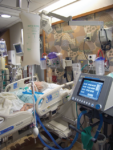Wabi-Sabi: Nursing and the Art of Brokenness
 Wabi-Sabi (Kintsugi), watercolor and acrylic on paper, 2018 by Julianna Paradisi
Wabi-Sabi (Kintsugi), watercolor and acrylic on paper, 2018 by Julianna Paradisi
Nursing is the art of healing, which ironically also makes it an art of brokenness. We pack and bind wounds. We administer medications to cure disease. We offer interventions for the side effects caused by the medication administered to cure.
We work in a health care system which, despite our best intentions, is broken: not enough resources, not enough staff or providers, not enough health care to go around for everyone.
Nurses have broken areas within ourselves too, but our work environments expect us to perform as perfectly as possible, amidst the brokenness of our patients, the brokenness of health care.
Patients, physicians, other departments, and hospital administrators expect nurses will fix problems, whatever they are, despite the brokenness.
A timely example this flu season is the paradoxical message: “Don’t come to work sick,” coupled with the implication, “Your sick call leaves us understaffed.”
The answer to brokenness is wholeheartedness.
The effort to fix the brokenness or imperfection of nursing and health care may be particularly exhausting for nurses because we are directly responsible for the safety of our patients.
The words of author David Whyte as he recounts a wise friend’s advice elegantly […]




